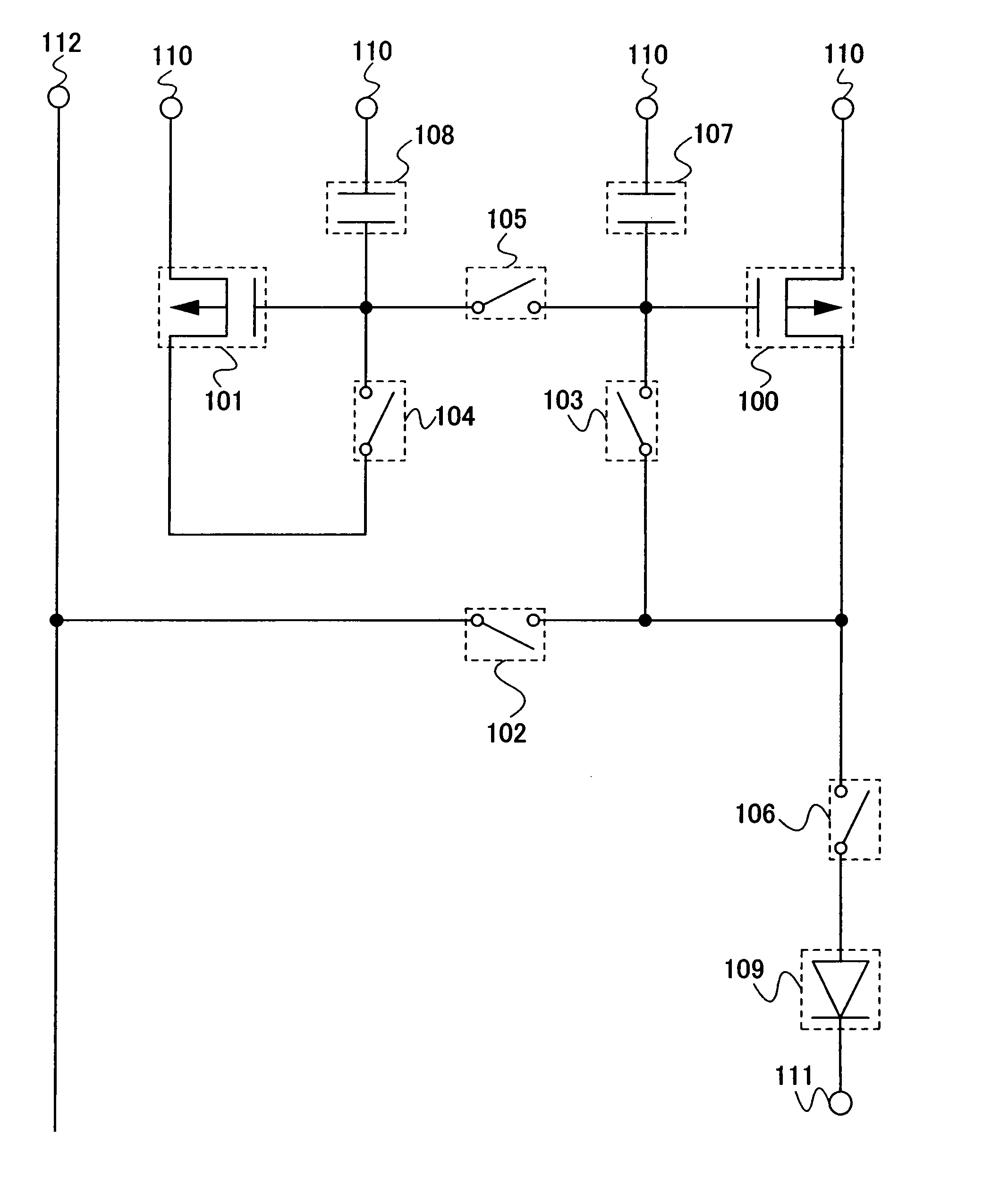Display device and driving method of the same
a technology of a display device and a driving method, which is applied in the direction of static indicating devices, instruments, electroluminescent light sources, etc., can solve the problems of long writing time, insufficient writing time for writing a slight amount of current, and limited capacitance of two capacitors, etc., to achieve accurate writing, shorten writing time, and improve image quality
- Summary
- Abstract
- Description
- Claims
- Application Information
AI Technical Summary
Benefits of technology
Problems solved by technology
Method used
Image
Examples
embodiment mode 1
[Embodiment Mode 1]
[0109] In this embodiment mode, description is made with reference to FIG. 1 of a configuration of a display device including a transistor for writing a video signal and controlling a current to be supplied to an EL element, and a transistor for obtaining a threshold voltage in order to shorten writing time per pixel.
[0110] In FIG. 1, a first transistor 100 is a transistor which operates in a saturation region and controls a current value flowing through an EL element 109 by a gate-source voltage thereof. A second transistor 101 is a transistor which has similar characteristics to the first transistor 100, such as a threshold voltage and mobility and is coupled with the first transistor 100. Each of a first switch 102, a second switch 103, a third switch 104, a fourth switch 105, and a fifth switch 106 has two terminals and a control terminal. They are switching elements which control conduction (on) or non-conduction (off) between the two terminals by the contro...
embodiment mode 2
[Embodiment Mode 2]
[0125] In Embodiment Mode 1, a transistor can be used as a switching element. This embodiment mode describes a configuration where a p-channel transistor is used as a switching element with reference to FIG. 5.
[0126] In FIG. 5, the first transistor 100, the second transistor 101, the first capacitor 107, the second capacitor 108, the EL element 109, the power source line 110, the counter electrode 111, and the source signal line 112 are similar to those in Embodiment Mode 1. A third transistor 502, a fourth transistor 503, a fifth transistor 504, a sixth transistor 505, and a seventh transistor 506 each has a function as a switching element and operates in a linear region. The third transistor 502, the fourth transistor 503, the fifth transistor 504, the sixth transistor 505, and the seventh transistor 506 are controlled by a digital signal from a first gate signal line 512, a second gate signal line 513, a third gate signal line 514, a fourth gate signal line 51...
embodiment mode 3
[Embodiment Mode 3]
[0139] This embodiment mode describes a configuration of a display device for controlling a current supplied to an EL element by using a transistor which obtains a threshold voltage in order to prevent characteristics deterioration of a transistor due to the concentration of current to one of the transistors with reference to FIG. 7.
[0140] In FIG. 7, the first transistor 700 is a driving transistor which operates in a saturation region and controls a current value supplied to an EL element 709 by a gate-source voltage. The second transistor 701 has characteristics such as a threshold voltage and mobility similar to those of the first transistor 700 and is paired with the first transistor 700. The first switch 702, the second switch 703, the third switch 704, the fourth switch 705, and the fifth switch 706 are switching elements each having two terminals and a control terminal, which are controlled to be conductive (on) or non-conductive (off) between the two term...
PUM
 Login to View More
Login to View More Abstract
Description
Claims
Application Information
 Login to View More
Login to View More - R&D
- Intellectual Property
- Life Sciences
- Materials
- Tech Scout
- Unparalleled Data Quality
- Higher Quality Content
- 60% Fewer Hallucinations
Browse by: Latest US Patents, China's latest patents, Technical Efficacy Thesaurus, Application Domain, Technology Topic, Popular Technical Reports.
© 2025 PatSnap. All rights reserved.Legal|Privacy policy|Modern Slavery Act Transparency Statement|Sitemap|About US| Contact US: help@patsnap.com



